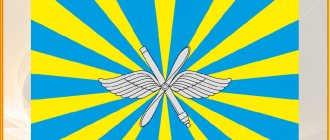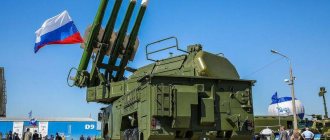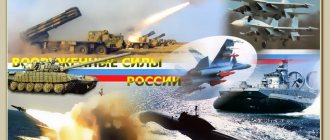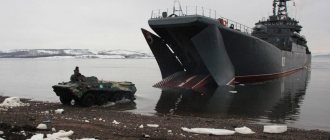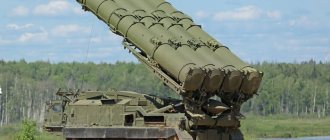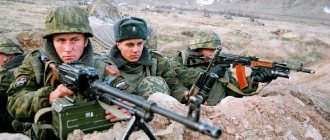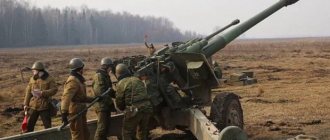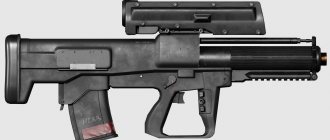06/14/2019 Category: Airborne troops
- 2 History of creation
- 3 Formation of troops in the USSR
- 4 Airborne troops in the modern army
- 5 Structure of the Russian Airborne Forces
- 6 Armament of the Airborne Forces
- 7 Dress code
- 8 Holiday
- 9 Interesting facts
Airborne troops (Airborne Forces) are an independent branch of the Armed Forces of the Russian Federation, designed for operational landing and combat operations behind enemy lines. The Airborne Forces are the reserve of the Supreme Commander-in-Chief and are directly subordinate to the Airborne Forces commander.
Airborne troops
General information and main tasks of the Airborne Forces
Airborne troops perform the following tasks:
- violation of enemy command and control;
- destruction of ground elements of precision weapons;
- failure to deploy reserves;
- disruption of the work of rear structures and communications;
- covering individual directions, areas and flanks;
- blocking and destroying enemy airborne assault forces and enemy groups that have broken through.
Airborne units are delivered to the combat area using airplanes, helicopters or gliders, and therefore are often used as quick reaction forces in local conflicts.
Paratroopers in gear and ready for takeoff
All about the Airborne Forces
The Armed Forces of the Airborne Forces - the airborne troops of Russia - are used where other units cannot reach. All about the Russian Airborne Forces, briefly:
- parachuted from the air (sometimes with heavy equipment, sometimes right in it);
- Russian paratroopers land on lethal means, such as helicopters, seaplanes, etc., on pre-prepared sites (landing method);
- in rare cases, a parachuteless method is used: the plane descends to a maximum depth of 2 m and releases long strips of material from the hatches, along which soldiers literally slide.
See also the article Airborne troops and their history
Tasks of the Airborne Forces
Russian airborne troops quickly carry out tasks to disorganize the enemy. The structure of an airborne battalion is determined by the command, depending on the tasks for the unit. Among which:
- encircling the enemy from the air;
- conducting operations in the rear (capture or destruction of territories and important points, disruption of communications, destruction of food and other resources of the enemy and other obstacles to the enemy’s work in the rear);
- delay of enemy reserve forces: all sorts of obstacles and disruptions to advance and deployment;
- interference with the command of enemy troops;
- destruction or seizure of weapons, incl. high-precision ground;
- assistance, cover or defense of ground troops or territories, preparation of amphibious landings;
- blocking (even to the point of destruction) the airborne forces and other enemy units that have penetrated our territory, etc.
See also the article Russian Motorized Rifle Troops and their structure
The tasks of the Airborne Forces do not include:
- breakthrough or capture of fortified lines with long-term defensive structures;
- long-term tough defense.
The appearance of the Airborne Forces was predicted in literature in 1824 by the science fiction writer Thaddeus Bulgarin in “Wandering around the World in the 29th Century.”
Formation of troops in the USSR
The first landing of troops took place in Turkestan in 1929 during the capture of the city of Garm. Then a detachment of Red Army soldiers was parachuted into territory controlled by the Basmachi and destroyed the enemy.
Created in 1931, the aviation motorized landing force had already grown to 29 airborne battalions by 1933. They were armed not only with small arms in the form of machine guns and sniper rifles, but also light tanks, motorcycles, 76 mm guns and armored personnel carriers.
In 1935, the first mass landing exercises took place in the Kiev Military District. 1188 Red Army soldiers captured the “enemy” airfield within 2 hours.
In 1936, 3,000 paratroopers and 8,000 people landed on the territory of the Belarusian Military District. At the same time, they landed together with light military equipment. The exercises turned out to be so large-scale and effective that they were reflected in the assessment of foreign observers.
Landing of military personnel from their aircraft
During the Great Patriotic War, the widespread use of airborne troops led to the formation of 10 regiments and 5 brigades by 1943. In 1942, the first Airborne Forces School was created in the city of Kuibyshev.
For heroism and courage during the war, 296 paratroopers received the highest award - Hero of the Soviet Union, and thousands of paratroopers were awarded orders and medals.
Since July 10, 1946, the Airborne Forces have been part of the country's Ground Forces, reporting directly to the USSR Minister of Defense, and since 1953 they have become his main reserve.
In the 50s - 80s of the twentieth century, airborne troops participated in many local conflicts in Europe and on other continents. Combat operations in Prague and Bratislava, Czechoslovakia, Angola, and Afghanistan were carried out by airborne forces. Moreover, this is not a complete list of countries and cities in which Soviet paratroopers were able to relieve the intensity of political passions and stop fratricidal wars.
History of the creation of the Airborne Forces (briefly)
The legendary history of the creation of the Russian Airborne Forces is listed in the table:
| date | Place | Event |
| Spring 1929 | Tajikistan, Garm | Year of creation of the Airborne Forces. The first use of airborne assault - a group of armed Red Army soldiers dropped from the air defeated a foreign gang with the support of local |
| August 2, 1930 | Moscow Military District, exercises | First appearance of parachute landing |
| Late 1930 | near Voronezh | The first airborne unit was created - an airborne detachment |
| 1931 | Leningrad Military District | Airborne detachment (164 people) - non-standard, experienced
In service: Kurchevsky dynamo-reactive guns; wedges, grenade launchers, (armored vehicles), light and heavy machine guns, cars and trucks, motorcycles and scooters |
| 1932 | Revolutionary Military Council of the USSR | Resolution on the deployment of special purpose air battalions |
| Late 1933 | Leningrad Military District | The Air Force included 29 airborne battalions and brigades. It was decided to continue the development of the Airborne Forces, the training of instructors and the development of standards was organized |
| 1934 | Red Army exercises | 600 paratroopers |
| 1935 | Kyiv Military District, exercises | A mass airborne landing (1,188 paratroopers on parachutes and 2,500 soldiers with military equipment) was practiced - a 2-hour operation to capture Brovary airport |
| 1936 | Belarusian Military District, review with invited foreign delegations | 3000 paratroopers + 8200 people with military equipment, landed by landing method |
| 1938 | 352 paratroopers received orders and medals | |
| 1939 | Mongolia, Khalkhin Gol | Defeat of the Japanese in a local border conflict |
| 1939—1940 | Finland | Combat military operations |
| 1940 | Bessarabia, Bolgrad and Izmail | Annexation of Bessarabia to the USSR |
| 1940 | New staffing levels approved for parachute, landing and glider combat groups | |
| Beginning 1941 | The composition of the Russian Airborne Forces was replenished with 5 corps, 10,000 fighters each | |
| August 29, 1941 | Order No. 0329 | The Airborne Forces become an independent branch of the military: the post of Commander of the Airborne Forces appears, and the apparatus of the Airborne Forces Directorate of the Red Army is approved. |
| September 4, 1941 | Order No. 0083 | Formed:
|
| Winter 1942 | near Vyazma | Counteroffensive, airborne logistics operation |
| September 1943 | Battle of the Dnieper | Assistance in crossing the river to the troops of the Voronezh Front |
| October 1944 | The Airborne Forces turned into a separate guards airborne army and began to be considered long-range aviation | |
| December 18, 1944 | Directives Rates | The Airborne Forces are subordinate to the Air Force. The airborne divisions were reorganized into rifle divisions. The composition remained 3 airborne brigades, an aeronautical division, and an airborne training regiment. |
| April 15-16, 1945 | Vein | Strategic operation - attack on Vienna |
| May 6-11, 1945 | Poland and Czech Republic | Participation in the Prague operation with access to the Elbe |
| August 1945 | Manchuria | Participation of 4000+ people in a strategic operation |
| 1941—1945 | Tens of thousands of soldiers received orders and medals, 126 became Heroes of the Soviet Union | |
| 1946 | The airborne forces became part of the ground forces and for several decades were the largest airborne forces in the world | |
| Late 1940s | North Pole | Landing in full combat gear |
| 1956 | Hungary | Participation in the Hungarian uprising |
| Late 1960s | Airborne assault units created | |
| 1968 | near Prague and Bratislava, Operation Danube | Combat operations at two Czechoslovakian airfields |
| 1970-1980s | Creation:
All this comes to the disposal of the USSR Airborne Forces | |
| 1979—1989 | Afghanistan | The most massive airborne combat operation in the USSR was the 5th Panjshir operation, in 3 days more than 4,000 people landed from helicopters |
| 1982—1983 | The emblem of the Russian Airborne Forces was approved, units received uniforms and insignia of the Airborne Forces | |
| 1982—1986 | Replacement of airborne armored vehicles (BMD-1, BTR-D) with motorized rifle vehicles (BMP-2D, BTR-70) | |
| Mid 1980 | The Airborne Forces include:
| |
| 1992 | The Russian Airborne Forces were officially formed from all divisions and brigades of the Airborne Forces that were located on the territory of the RSFSR + some units from Georgia, Azerbaijan, Turkmenistan, Lithuania, Ukraine and Moldova (in 1992-1993) |
Airborne troops in the modern army
The Airborne Forces of the Russian Federation are the legacy of the Union of Soviet Socialist Republics, divided in 1992 between the union republics. The troops became the reserve of the Supreme Commander-in-Chief, the main tasks remained unchanged.
Airborne troops during a ceremonial march
Structure of the Russian Airborne Forces
The Russian Airborne Forces consist of command structures, combat units and units, as well as support units.
Structurally, the Airborne Forces have three main components:
- airborne;
- air assault;
- mountain - air assault units designed to operate in mountainous areas.
The Russian Airborne Forces include four divisions, as well as separate brigades and regiments:
- 76th Guards Air Assault Division, stationed in Pskov.
- 7th Guards Air Assault (Mountain) Division, stationed in Novorossiysk.
- 98th Guards Airborne Division, located in Ivanovo.
- 106th Guards Airborne Division - Tula.
- 11th Separate Guards Airborne Brigade, based in Ulan-Ude.
- 45th separate guards special purpose brigade (Moscow).
- 56th Separate Guards Air Assault Brigade. Place of deployment - the city of Kamyshin.
- 31st Separate Guards Air Assault Brigade. Located in Ulyanovsk.
- 83rd Separate Guards Airborne Brigade. Location: Ussuriysk.
- 38th Separate Guards Airborne Communications Regiment. Located in the Moscow region, in the village of Medvezhye Ozera.
In addition, the Russian Airborne Forces include educational institutions:
- Ryazan Higher Airborne Command School;
- Tula Suvorov School;
- Ulyanovsk Suvorov School;
- Omsk Cadet Corps;
- The 242nd training center, located in Omsk.
Formation at RVVDKU
Composition of the Russian Airborne Forces
Number of troops: 45,000 fighters.
Three main directions:
- air assault;
- air assault (mountain);
- parachute landing.
Structure of the Airborne Troops:
- control center (Air Force headquarters);
- formations (4 divisions: 7th, 76th, 98th and 106th);
- 5 separate brigades (11th, 31st, 45th, 56th and 83rd);
- individual units (signals regiment, reconnaissance regiment, medical detachment and repair and restoration battalion);
- more than 100 divisions;
- educational institutions (Ryazan - high command, Omsk - cadet corps and training center, Ulyanovsk - military school, Moscow - school for warrant officers, etc.).
See also the article Semenovsky Regiment (military unit 75384) and its history
Airborne Forces
Armament of the Airborne Forces
The airborne troops are armed with the same small arms as other troops, but with special modifications: a folding stock for machine guns and carbines. Silent shooting devices were also developed - PBS for pistols, machine guns and rifles.
Small arms for special-purpose units are represented not only by silent weapons such as “Val” and “Vintorez”. The Airborne Forces were the first to receive the latest AK-12 assault rifles and IED rifles with a bullpup cartridge supply system. This system differs in the location of the magazine in the butt, which makes the rifle shorter.
Airborne combat vehicles - BMD-1, BMD-2M, BMD-3 and BMD-4 and armored personnel carriers BTR-80, BTR-D accompany the air infantry in all operations.
Construction of personnel and weapons of the Airborne Forces
The main anti-tank weapons of the Airborne Forces are the 2S25 Sprut-SD self-propelled anti-tank gun, the Robot BTR-RD complexes, as well as the Metis, Fagot, Konkurs and Kornet ATGMs.
Modern military equipment is designed in such a way that it is suitable for landing from an aircraft, with a crew on board.
Airborne Forces symbols
Airborne flag
The flag of the USSR Airborne Forces was born simultaneously with the creation of the Airborne Forces themselves - in 1930, although it was officially unified in 1955. The blue stripe of the sky (2/3 of the flag) turns into a green stripe of the earth (1/3 of the flag), in the middle of the flag is a paratrooper on a parachute with a red a star and two planes on the sides.
Flag of the USSR Airborne Forces
Its successor, the flag of the Russian Airborne Forces, removed the symbol of the USSR, and moved the parachutist entirely to an enlarged blue stripe, so that he only touches the green stripe with his feet, and is not entirely on it. The new look was officially confirmed on June 14, 2004.
Flag of the Russian Airborne Forces
Motto
Motto: “Nobody but us.” Sometimes it is added to the flag (in yellow letters, above or below the parachute), but this version is not official.
Airborne emblems
The Airborne Forces emblems received approval from the Minister of Defense almost a year later - on May 6, 2005.
Small - a golden winged grenade (a spherical hand grenade) with flames on top.
The middle one is a golden crowned double-headed eagle with a silver sword in the right paw and a silver winged grenade in the left. On the eagle’s chest, between its outstretched wings, is a red shield with a spear-rider defeating a dragon. In essence, this is a combination of the small emblem of the Airborne Forces and the general emblem of the RF Armed Forces.
The large one (which is also the coat of arms) is another combination of the small and medium emblems. A golden winged grenada against a background of a round blue shield, around which is a golden oak wreath with a golden crowned double-headed eagle at the top. In its paws the eagle holds a golden sword (in the right) and a laurel wreath (in the left), its chest is protected by a red shield with a horseman defeating a dragon (this is the emblem of the Russian airborne troops).
See also the article State Emblem of Russia and its history
Airborne Forces Education Day
Paratrooper's Day: August 2.
Form
Blue beret (until 1969 - crimson, by A.B. Zhuk, known from books about small arms), blue and white vest.
Other official symbols of the "winged infantry"
| Image | Affiliation with the Airborne Forces |
| Patch in the USSR (1969-1991) | |
| Sleeve insignia in the Russian Federation | |
| Command sleeve insignia | |
| Lapel badge |
Distinctive insignia of each airborne brigade
In addition to the general insignia, each division and each airborne brigade has its own emblems, stripes and mottos.
See also the article Insignia of the Airborne Forces and their history of emblems
| Sign | Description |
| 98th Guards Svir Airborne Division, awarded the Orders of Kutuzov and the Red Banner Parts: Ivanovo, Kostroma and Yaroslavl regions; Headquarters: Ivanovo; Motto: “Honor and Motherland above all!” Year of creation: 1944 It became famous already in the year of its creation during the crossing of the river. Svir, which is why it got its name. The punishing sword is an ancient symbol of punishment for encroachment on independence. | |
| 7th Guards Division (mountain airborne assault), awarded the Orders of Kutuzov, Suvorov and the Red Banner Units: Novorossiysk Headquarters: Novorossiysk Motto: “Courage, courage, honor!” Year of creation: 1948 The bison is a historical symbol of the Lithuanian city of Kaunas, the place of long-term deployment of the DShD(g). | |
| 76th Guards Division (Air Assault), awarded the Orders of Suvorov and the Red Banner Parts: Pskov region Headquarters: Pskov Motto: “We are everywhere where victory is expected!” Year of creation: 1939 The Chernigovskaya received the title for its active offensive and capture of Chernigov in 1943. The leopard on the emblem is a symbol of Pskov. | |
| 106th Guards Airborne Division, awarded the Orders of Kutuzov and the Red Banner Units: Tula, Ryazan, Naro-Fominsk Headquarters: Tula Motto: “No task is impossible!” Day: April 26 Year of creation: 1944 It was here that the Centaur system was tested - a landing of combat vehicles with people inside. | |
| 104th Guards Airborne Division, awarded the Order of Kutuzov currently being restored from 31 separate guards brigade (air assault) Location: Ulyanovsk Year of creation: 1944 Motto: “Honor to yourself, glory to your homeland!” Scorpio is a tribute to history, since for more than 45 years the division underwent combat training in mountainous desert areas. | |
| 11th separate guards brigade (air assault) Location: Ulan-Ude; Year of creation: 1968 Motto: “From any heights to any heat!”, “Honour to yourself, Memory to Descendants, Glory to the Motherland” | |
| The 56th Separate Guards Brigade (Air Assault), also known as the Don Cossack Brigade, was awarded the Order of the Patriotic War Location: Kamyshin; Year of creation: 1943 | |
| 45th separate guards brigade (special purpose) Location: Moscow, Kubinka; Year of creation: 1994 Motto: “The strongest wins!” | |
| 83rd separate guards brigade (air assault) Location: Ussuriysk; Year of creation: 1986 Motto: “Honor is more valuable than life!” |
Dress
For everyday wear, a standard military uniform is used, with the exception of the blue beret, recognizable throughout the world. Only Russian paratroopers wear a blue beret. The paratroopers of other countries take maroon, crimson or red. The buttonholes, shoulder straps, band on the cap and piping on the uniform trousers are also blue.
Another distinctive feature of the paratrooper uniform is the vest. Unlike the naval undershirt, the paratrooper’s “vest” has light blue stripes. Airborne Forces Commander V.F. Margelov often checked his officers for wearing this attribute of the uniform. And if under his uniform the officer had standard underwear instead of a vest, he was shown the door.
During field training, a soldier's headdress is a cap, hat or Panama hat.
The field uniform has changed many times over the decades. The reason for this was the constant work to improve and modernize clothing based on the results of combat and training operations. For example, after the events in Angola and a number of other African countries, the famous “mabuta” was developed - a field uniform with patch pockets on a soldier’s trousers and jacket. And among the paratroopers, the uniform received its name from the name of General Mabuta, who was assisted in that local conflict on the territory of an African state.
Airborne uniform then and now
The paratroopers are the first to receive all the new military uniforms. After all, they, like no one else, can check its convenience, wearability, quality, etc. Another example of such a form, born of a military conflict, is the “slide,” which became widely used after the war in the Caucasus.
